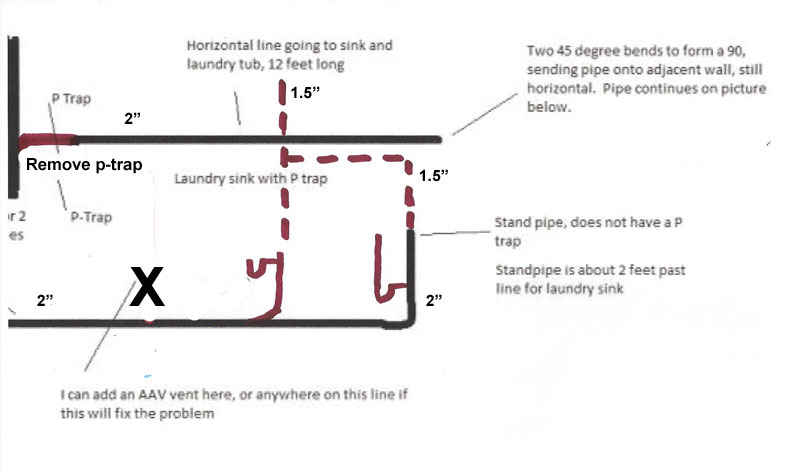The plumbing in my laundry room seems to be missing a vent, or there are too many P-traps.
The current setup is this:
The sanitary line that goes to the laundry room connects to my main sanitary line while it is horizontal. The line going to the laundry room is 1 1/2 inches. Immetidately on the line there is a p trap. This trap is vented about 2 feet downstream with the main vent for the house going through the roof.
The pipe going into the laundry room runs about 14 feet horizontally, then there is a tee which goes to the laundry sink. The other side of the tee goes to the standpipe for the washing machine. The standpipe does not have a P trap. It has a 90 degree bend that sends it vertical.
The sink has it's own P trap. It is not vented.
My options are either to eliminate the P-trap on the sink, leaving only the trap 14 feet down the line, or leave the trap on the sink, add one to the standpipe, and add a cheater vent. Which option is better?
Also, I'd like to add a cleanout to this line. Where would be the best place for this?
Thanks!
The current setup is this:
The sanitary line that goes to the laundry room connects to my main sanitary line while it is horizontal. The line going to the laundry room is 1 1/2 inches. Immetidately on the line there is a p trap. This trap is vented about 2 feet downstream with the main vent for the house going through the roof.
The pipe going into the laundry room runs about 14 feet horizontally, then there is a tee which goes to the laundry sink. The other side of the tee goes to the standpipe for the washing machine. The standpipe does not have a P trap. It has a 90 degree bend that sends it vertical.
The sink has it's own P trap. It is not vented.
My options are either to eliminate the P-trap on the sink, leaving only the trap 14 feet down the line, or leave the trap on the sink, add one to the standpipe, and add a cheater vent. Which option is better?
Also, I'd like to add a cleanout to this line. Where would be the best place for this?
Thanks!



